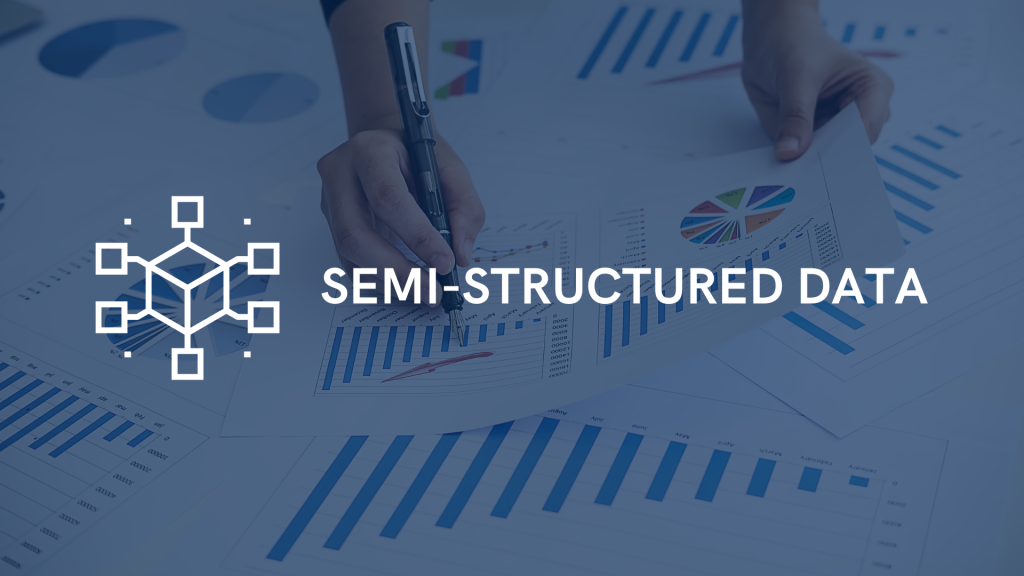Typically, data was neatly and efficiently organised in databases or spreadsheets.
Since the introduction of the cloud, mobile apps, websites, and IoT devices, data has expanded in variety.
When successfully mined, such data can prove to be quite beneficial for enterprises.
High volume and a wide diversity of data make up big data.
Big Data comes in three flavours: structured, semi-structured, and unstructured.
Semi-structured data is any type of data that is not maintained in traditional data models and does not adhere to a strict or fixed tabular structure.
Between structured and unstructured data is semi-structured data.
Both humans and machines can understand and quantify structured data.
On the other hand, unstructured data consists of information that isn’t numerical and that computers can’t process.
What Is Semi-Structured Data?
Data that is neither captured nor formatted typically is referred to as semi-structured data.
Because semi-structured data lacks a fixed schema, it does not adhere to the format of a tabular data model or relational databases.
The data does have certain structural components, such as tags and organisational metadata, which facilitate analysis, so it is not entirely unstructured or raw.
Compared to structured data, semi-structured data has the advantages of being more adaptable and easier to scale.
Emails, for instance, can be semi-structured by Sender, Recipient, Subject, Date, etc.
Or they can be automatically sorted into folders like Inbox, Spam, Promotions, etc. with machine learning.
Innovative Tech Solutions, Tailored for You
Our leading tech firm crafts custom software, web & mobile apps, designed with your unique needs in mind. Elevate your business with cutting-edge solutions no one else can offer.
Start NowRead: Labelled Data vs Unlabelled Data in Machine Learning

Structured data
Structured data is distinct from semi-structured data in that it is highly organised and quantified information that was specifically created to be searchable.
It typically lives in relational databases (RDBMS) and is frequently written in structured query language (SQL), a standard language developed by IBM in the 1970s for interacting with databases.
Both humans and machines can enter structured data, but they must adhere to a rigid framework with predetermined organisational qualities.
Imagine a database for a hotel where guests can be found using their names, phone numbers, room numbers, etc.
Or spreadsheets with data nicely organised into rows and columns.
Read: How to Master SQL and Query Databases Easily
Unstructured data
Open text, pictures, videos, and other types of unstructured data typically lack any predetermined structure or design.
Consider documents, reviews, and other internet sources that provide qualitative information about beliefs and emotions.
Although this data must first be formatted so that machines can evaluate it, it can be processed using machine learning approaches to extract insights despite being more challenging to examine.
In essence, semi-structured data is a synthesis of the two.
For instance, meta tags for locations, dates, and photographers may be included in photos and films, but the information they provide lacks organisation.
Consider social networking sites like Facebook, which classifies content by Users, Friends, Groups, Marketplace, etc.
But the comments and text inside these sections are unstructured.
Semi-structured data is simpler to study than structured data because it has a somewhat higher level of organisation.
However, it must first be deconstructed using machine learning technologies to be analysed without human involvement.
Additionally, it contains quantitative data that might offer far more insightful analysis, exactly like entirely unstructured data.
Read More: Structured vs Unstructured Data: What Are The Differences
Who Uses Semi-Structured Data?
Semi-structured data can be used by organisations of all sizes and in a wide range of sectors.
To understand their consumer base, several businesses collect semi-structured data.
Let’s take the example of a business asking its clients for online reviews.
Because these internet reviews are written in a human language that computers find difficult to grasp, their textual content would be unstructured.
However, some sorts of structured data, like the average number of consumers who gave a product five stars, may also be present in these online evaluations.
Semi-structured data is widely used by businesses to improve their protocols or workflows.
Seamless API Connectivity for Next-Level Integration
Unlock limitless possibilities by connecting your systems with a custom API built to perform flawlessly. Stand apart with our solutions that others simply can’t offer.
Get StartedAn organisation might, for instance, gather quantitative information regarding the effectiveness of several operational processes.
However, they probably also consider unstructured data types, such as employee input, to increase the efficiency of these procedures.
When these many data sets are combined, businesses have semi-structured data they can utilise to understand better how to optimise their workflows.
Read: The Power of Data Analytics: How Insights Can Drive Business Decisions
Examples of Semi-Structured Data
There are many different semi-structured data formats, each with its own set of uses.
Some have a very complex hierarchical structure, while others are barely structured at all.
1. CSV
CSV, XML, and JSON are the three primary languages used to communicate with or transfer data from a web server to a client (i.e., computer, Smartphone, etc.).
The term “comma-separated values” (CSV) refers to data that is expressed as the names Lucy, Jessica, and Anthony.
It can be expressed similarly to Excel files, but with a single column instead.
2. Email
Since we all regularly use email, email may be the most prevalent sort of semi-structured data.
Email messages are categorised into folders like Inbox, Sent, Trash, and other similar names and contain structured data like name, email address, recipient, date, time, and so on.
The data inside every email is unstructured, even though the majority of email software products let you search by keyword or other languages.
Emails may offer businesses a wealth of data mining opportunities for customer feedback analysis.
This ensures customer service is operational, and helping to create marketing materials.
3. Web Pages
With tabs like Home, About Us, Blog, Contact, and others, as well as connections to other sites within the text, web pages are made to be simply accessible to assist readers discover the information they need.
Of course, all of this is written in HTML, but the computer monitor obscures that.
Additionally, none of these pages’ language or data is structured.
4. HTML
The hierarchical language known as HTML, or “Hyper Text Markup Language,” is comparable to yet distinct from XML.
Websites are made using HTML, which also helps to visualise data.
The semi-structured HTML is provided by the commentaries used to display text and images on a computer screen.
But the text and images are not organized in any way.
5. NoSQL Databases
The most popular forms of non-relational databases, often known as NoSQL (“not just structured query language” or “non SQL”) databases, include document, key-value, wide-column, and graph.
They can store both organised and unstructured data, making them flexible data storage options. and, because to their simplicity in scaling, are excellent for semi-structured data.
Unstructured data can be made simpler to search and analyse with just one additional layer of structure (topic, value, data type, etc.).
Transform Business with Custom CRM & ERP Solutions
Elevate your operations with a CRM or ERP tailored for you. Let’s build the perfect solution that others can't replicate—crafted to match your business's needs like no other.
Get Started
Pros & Cons of Working With Semi-Structured Data
Semi-structured data is not limited by a predetermined architecture.
As a result, a NoSQL database, for instance, can readily scale to store enormous volumes of data in any required format.
Unfortunately, this makes it much more challenging to evaluate the data.
This is because it must either be manually processed or arranged in a way that computers can understand.
Although semi-structured data is far more portable and storable than entirely unstructured data, the storage cost is typically substantially higher.
The flexibility of semi-structured data allows for schema changes.
Still, because the schema and data are frequently too intertwined, you have to already know the data you’re looking for when running queries.
Conclusion
Semi-structured data can be considerably more illuminating for understanding your clients’ thoughts and feelings.
But it is more challenging to evaluate than structured data.
Additionally, obtaining the information required to make data-driven decisions can be ridiculously simple when using machine learning text analysis technologies.
The development of leads and subsequent conversion are the ultimate goals of real estate marketing.
Before You Go…
Hey, thank you for reading this blog post to the end. I hope it was helpful. Let me tell you a little bit about Nicholas Idoko Technologies.
We help businesses and companies build an online presence by developing web, mobile, desktop, and blockchain applications.
We also help aspiring software developers and programmers learn the skills they need to have a successful career.
Take your first step to becoming a programming expert by joining our Learn To Code academy today!
Be sure to contact us if you need more information or have any questions! We are readily available.











